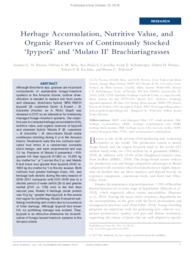Herbage accumulation, nutritive value, and organic reserves of continuously stocked 'Ipyporã' and 'Mulato II' Brachiariagrasses.
Herbage accumulation, nutritive value, and organic reserves of continuously stocked 'Ipyporã' and 'Mulato II' Brachiariagrasses.
Autoria: PARAISO, I. G. N.; SILVA, D. S. M.; CARVALHO, A. P. S.; SOLLENBERGER, L. E.; PEREIRA, D. H.; EUCLIDES, V. P. B.; PEDREIRA, B. C.
Resumo: Although Brachiaria spp. grasses are important components of sustainable forage?livestock systems in the Amazon biome, cultivar diversification is needed to reduce risk from pests and diseases. Brachiaria hybrid ?BRS RB331 Ipyporã? [B. ruziziensis Germ. & Evrard ´ B. brizantha (Hochst. ex A. Rich.) Stapf] was released in 2017 as an alternative for intensively managed forage?livestock systems. Our objective was to compare herbage accumulation (HA), nutritive value, and organic reserves of Ipyporã and standard hybrid ?Mulato II? (B. ruziziensis ´ B. brizantha ´ B. decumbens Stapf) under continuous stocking during 2 yr in the Amazon biome. Treatments were the two cultivars replicated four times in a randomized complete block design, and each experimental unit was 1.5 ha. Pastures of Mulato II presented 15% greater HA than Ipyporã (17,360 vs. 14,930 kg dry matter ha−1 yr−1) across the 2 yr, and Mulato II leaf mass was greater than Ipyporã (1440 vs. 1900 kg dry matter ha−1) in the dry season. Both cultivars had greater herbage mass, HA, and herbage bulk density during the rainy season of 2016?2017 compared with 2017?2018 due to a shorter period of water deficit (30 d) and greater rainfall (2147 vs. 1762 mm) in the first than second year. Mulato II herbage crude protein was 10 g kg−1 greater than Ipyporã. In this severe risk region for spittlebug, Mulato II required spittlebug monitoring and control due to occurrence of foliar damage. Although Ipyporã had lesser HA, no spittlebug damage was evident. Thus, Ipyporã is an attractive alternative for diversification of forage-based livestock systems in the Amazon biome.
Ano de publicação: 2019
Tipo de publicação: Artigo de periódico
Unidade: Embrapa Gado de Corte
Palavras-chave: Amazonia, BRS RB331, Beef, Brachiaria sp, Ipypora, Livestock, Mato Grosso, Mulato II, Sinop-MT
Observações
1 - Por padrão são exibidas publicações dos últimos 20 anos. Para encontrar publicações mais antigas, configure o filtro ano de publicação, colocando o ano a partir do qual você deseja encontrar publicações. O filtro está na coluna da esquerda na busca acima.
2 - Para ler algumas publicações da Embrapa (apenas as que estão em formato ePub), é necessário ter, no celular ou computador, um desses softwares gratuitos. Sistemas Android: Google Play Livros; IOS: iBooks; Windows e Linux: software Calibre.
Acesse outras publicações
Acesse a Base de Dados da Pesquisa Agropecuária (BDPA) para consultar o acervo completo das bibliotecas da Embrapa.

